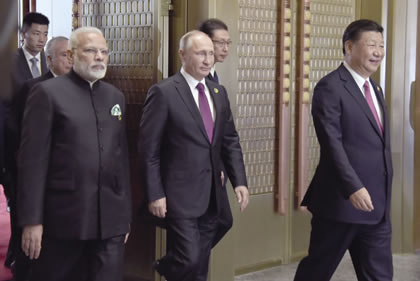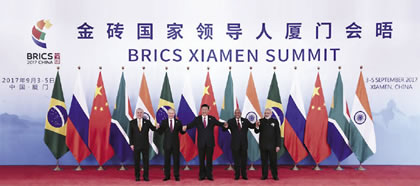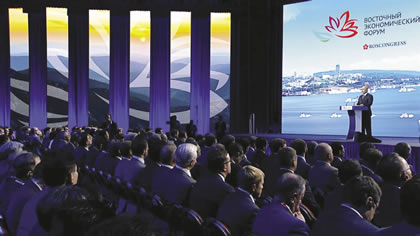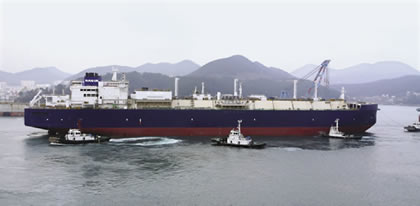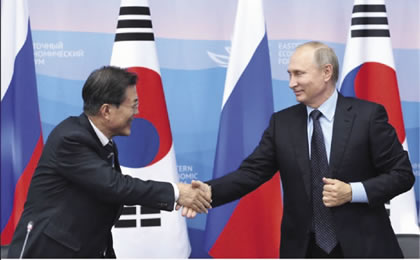CHINA AND RUSSIA DRIVE NEW PARADIGM
BRICS Summit and Eastern Economic
Forum Give Hope to Mankind
by Mike Billington
September 2017
A PDF version of this article] appears in the September 15, 2017 issue of Executive Intelligence Review and is re-published here with permission.
Sept. 9—Participants in the new world paradigm—including representatives of most of the human race—gathered together in two dramatic conferences during the week of September 3-8: the BRICS Summit in Xiamen, China, followed by the Eastern Economic Forum (EEF) in Vladivostok, Russia. These meetings could not have come at a more dramatic moment in history. The western financial system is facing a catastrophic collapse, exceeding by an order of magnitude the crisis which began in 2007. Faced with this looming disaster, the British empire, through its financial centers in the City of London, Wall Street, and across Europe, is resorting to extreme measures to sabotage this move by the majority of the world’s nations. The Chinese and Russian-led process, in rejecting the “Washington Consensus” (better called the British Empire straight-jacket), which imposed austerity and political-economic conditionalities on supposedly sovereign states, is instead engaging in the “win-win” policies of the China-Russia New Silk Road (Belt and Road Initiative), offering nation-building through infrastructure and industrial development, without political dictates.
|
Presidents Narendra Modi, Vladimir Putin, and Xi Jinping at the BRICS Summit in Xiamen, China. |
Perhaps even more frightening to the Lords of London and Wall Street, is the intention of President Donald Trump to join in this New Paradigm, to break the imperial East vs. West divide in favor of friendship with Russia and China, both in combatting international terrorism and through participation in the New Silk Road—including welcoming Chinese help in rebuilding the crumbling U.S. industry and infrastructure. This is the core motivation driving the British-directed coup attempt against President Trump.
Now is the time for the American people to back President Trump’s best intentions—to join in the phase shift in history demonstrated this past week in Asia. This has been the commitment of the LaRouche movement, including this journal, for the past fifty years—to bring the world together behind a “peace through development” perspective, bringing humanity out of its squabbling childhood to cooperate in building our world, and worlds beyond.
BRICS-Plus
China was the host for this year’s annual BRICS Summit, its tenth, comprising Brazil, Russia, India, China and South Africa. China’s President Xi Jinping, as the host, initiated a process he called BRICS-Plus, expanding the vision of BRICS-centered development by inviting five other nations representative of the developing sector in Southeast Asia, Africa, Ibero-America, Central Asia and the Mideast. (The participating countries were Thailand, Guinea, Mexico, Tajikistan, and Egypt.) At the concluding press conference of the BRICS Summit, President Xi said: “The dialogue of emerging market and developing countries hosted by China has sent a strong message for closer South-South cooperation and global development cooperation.” He said the BRICS needed to reach out extensively to other countries to forge development partnerships and establish an open and diverse network of development partners.
|
The 2017 BRICS Summit in Xiamen, southeast China’s Fujian Province, Sept. 4, 2017. |
Xi Jinping’s address to the BRICS Business Forum, which included business leaders from the BRICS and 20 other countries, praised the role of the BRICS over the past ten years, which held steady against the global economic crisis unleashed by the bursting of the speculative bubble in the US and Europe in 2007-08. “In the past ten years,” Xi said, “our combined GDP has grown by 179%, trade by 94%, and urban population by 28%. All this has contributed significantly to stabilizing the global economy and returning it to growth, and delivered tangible benefits to three billion and more people.”
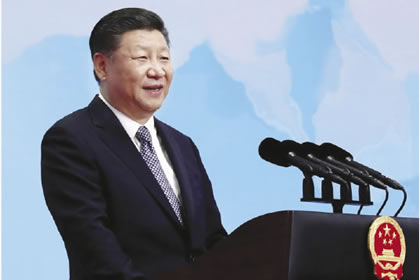
Xinhua/Ju Peng
Chinese President Xi Jinping delivers a keynote speech at the opening ceremony of the BRICS Business Forum, Sept. 3, 2017. |
Xi also said: “Some people, seeing that emerging market and developing countries have experienced growth setbacks, assert that the BRICS countries are losing their luster. It is true that, affected by complex internal and external environments, we BRICS countries have encountered headwinds of varying intensity. But the growth potential and trend of our countries remain unchanged, and we are fully confident about it.” The BRICS mechanism is characterized, he continued, by the fact that the countries treat each other as equals and seek common ground, taking a results-oriented innovative approach to matters so that the results will benefit all—they “developed themselves to help others with the well-being of the world in mind.”
He added: “BRICS is not a talking shop, but a task-force that gets things done, thus giving concrete expression to the endeavor of building a new type of international relations featuring win-win cooperation . . . The Belt and Road Initiative is not a tool to advance any geopolitical agenda, but a platform for practical cooperation. It is not a foreign aid scheme, but an initiative for interconnected development which calls for extensive consultation, joint contribution and shared benefits. I am convinced that the Belt and Road Initiative will serve as a new platform for all countries to achieve win-win cooperation.”
A major topic of discussion at the Summit was the functioning of the New Development Bank (NDB), the BRICS bank set up at the BRICS Summit in Brazil in 2014, which has begun lending over this past year, beginning with four infrastructure investments in Russia, China and India, totaling $1.4 billion. The first regional center of the NDB, the African Regional Center, was established in South Africa in August.
The South African Deputy Minister for International Relations, Luwellyn Landers, wrote in the Sept. 6 issue of Voices360: “The BRICS Bank was originally intended by the BRICS leaders to supplement the existing efforts of multilateral and regional financial institutions for global growth and development. However, the expectations for this Bank have clearly outweighed its modest origins, and it has now evolved to become a symbol of a new generation financial institution that will serve the developmental needs of the Global South.” He noted that NDB loans will be approved in a streamlined manner, and “without setting conditionalities, as is the case in the established Western Multilateral Development Banks.”
Landers continued: “The NDB comes at an opportune moment, as we transition from a unipolar world order with a declining power to a multi-polar world order, challenging the previous order’s hegemon(s). The BRICS Bank therefore provides emerging markets and developing countries with an alternative global financial and institutional architecture. It also provides the global South with an amplified voice to articulate our core needs and set new agendas according to shared rule-formulation practices. To this end the NDB has indicated a number of innovative measures that will ultimately challenge the pre-eminence that the Washington Consensus has cultivated since the post-Second World War era. For example, the NDB is embarking on facilitating loans in the local currency of its members, which indirectly challenges the role of previous dominant currencies. As a result, countries requesting a loan no longer need to absorb the uncertainty inherent in fluctuations of currency in respect of their repayments. This in itself will provide new certainty for lenders as well as borrowers, indicative of the type of qualitative paradigm shift intended with these initiatives.”
He added that the NDB will oversee the establishment of a BRICS rating agency, to provide an alternative to the London-New York agencies Standard and Poors, Fitch, and Moody’s. He noted that the NDB “will not impose its demands on the country needing assistance. This constitutes the fundamental difference between Chinese cooperation versus Official Development Assistance (ODA) from the West/OECD. The West has pursued, through its ODA programmes, a form of relationship which has been perceived as that of neo-colonialism.”
Great Projects
A number of large-scale infrastructure projects were officially signed on the sidelines of the BRICS Summit, in bilateral discussions between the heads of state. Thailand’s Prime Minister Prayut Chan-ocha signed a contract for China to build the first high speed railroad in the country, from Bangkok to Korat in Thailand’s Northeast, which will begin construction next month. This railroad will eventually be extended to Laos, to connect with the rail line China is building through Laos, thus connecting Kunming, China, and points north, to the ports in Thailand. Prayut intends to make Korat the hub for the development of the entire Mekong River region. Ironically, Korat was the site of one of the primary U.S. airbases which rained bombs and napalm across Laos, Cambodia and Vietnam during the Indochina War, but it will now be the center of the region’s development.
The Brazilian power companies Eletrobras and Eletronuclear signed an MOU with the China National Nuclear Corporation to facilitate China’s assistance in completing the long-delayed 1.4 MW Angra 3 nuclear power plant, which has been repeatedly stalled since its launch in 1984, for political reasons. Unfortunately, there was no mention of the Interoceanic Rail Corridor, a railroad project traversing the South American Continent, which was agreed upon by Brazil, China and Peru at the BRICS Summit in 2014 at Fortaleza, Brazil. President Michel Temer, who replaced the deposed President Dilma Rousseff, has undermined many of the projects which she had championed.
India and China
The presence of Indian Prime Minister Narendra Modi at the BRICS Summit was a critical step forward in the sometimes contentious relations between China and India. The military showdown which had festered for many weeks on the trilateral border of China, India and Bhutan, regarding contested sovereignty between Bhutan and China over the Doklam region, had threatened to undermine relations between the two Asian giants, and possibly prevent Modi’s attendance at the Summit. (Modi had skipped the Belt and Road Forum in Beijing in May.)
But the Doklam crisis was amicably settled just days before the BRICS Summit, and Modi played an important role in the proceedings. He met for over an hour privately with Xi Jinping, and agreed to work to improve trust and cooperation between the two nations. Both pointed to the historic China-India Treaty of 1954, in which the Five Principles of Peaceful Coexistence were codified, which became the basis for the agreement among the formerly colonized nations of Asia and Africa at the Bandung Conference in Indonesia in April 1955. These principles are respect for sovereignty and territorial integrity, non-aggression, non-interference in internal affairs, equality, and peaceful coexistence.
China had not wished to include reference to the terrorist organizations which are based in Pakistan in the final communiqué, due to concern for relations with Pakistan, but ceded ground to Modi on this issue, accepting reference to Lashkar-e-Taiba (LeT) and Jaish-e-Mohammed (JeM) in the joint statement. JeM is active against India in Kashmir, while LeT operates across South Asia, and has recently organized a terrorist operation within Myanmar among the Rohingya Muslim population. Modi visited Myanmar after the BRICS Summit, giving support to the Myanmar government in its fight against this terrorist network.
Eastern Economic Forum
Immediately following the BRICS Summit, over 3,500 people from 60 countries gathered in Vladivostok, Russia, for the third annual Eastern Economic Forum, targeting the development of the vast, resource-rich, but underdeveloped and under-populated Russian Far East. The Russian Far East, together with the Arctic, can be considered the last New Frontier on Earth, comparable to the development of the American West during our first century as a nation.
|
kremlin.ru
Vladimir Putin addressing the Plenary Session of the Eastern Economic Forum. |
In greetings sent to all the participants before the opening, President Vladimir Putin wrote: “Russia is faced with an ambitious target: to provide the best possible conditions for doing business in the Far East; to launch new manufacturing capabilities, and to create additional jobs. . . . Russia’s Far Eastern strategy is based on openness to collaboration and an interest in promoting the broadest possible international cooperation. As such, the theme of working together within multilateral structures such as the Eurasian Economic Community, the Shanghai Cooperation Organization, ASEAN, and APEC, takes up, by tradition, an important part of the Forum agenda. I am confident that your discussions will facilitate the development of effective models for combining various integration processes, and will help us to move further towards creating a Greater Eurasian partnership.”
Japan-Russia Cooperation: The two primary developments at the Forum were, first, Japan and South Korea’s participation in the process of developing the Russian Far East; and, secondly, the interrelated issue of solving the crisis regarding North Korea.
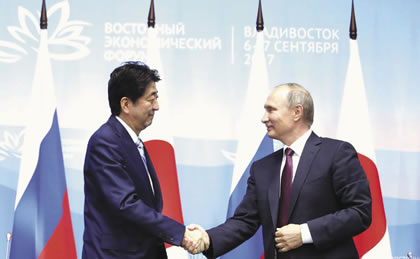
kremlin.ru
Russian President Vladimir Putin (right) and Japan Prime Minister Shinzo Abe at their joint press conference following their talks at the Eastern Economic Forum in Vladivostok. |
Of the 3,500 participants in the Forum, fully 1,300 were from Japan, including Prime Minister Shinzo Abe and three of his ministers, and a large number of business leaders. The growing friendship between Abe and Putin was further consolidated, with concrete discussion of building a rail connection between Russia and Japan—first from the Russian mainland to Sakhalin Island, and then from Sakhalin to Japan’s northern island, Hokkaido. Putin described the project as “absolutely global in nature,” and suggested it could be completed within three to five years.
A Japanese economist who attended the Forum said that the Japanese business leaders were extremely enthusiastic, perceiving that the political relations between the two countries—which have never signed a peace treaty from World War II due to conflicting sovereignty claims over the four Kuril Islands (called the Northern Territories in Japan)—had so improved that they could begin to think freely of joint investment and development projects, without concern that political problems would interfere.
|
ww.ep.total.com
The world’s first icebreaking liquefied natural-gas tanker will be the flagship of a 15-vessel Russian fleet for huge projects, with Chinese, French, and other partners, in the resource-rich Russian Arctic. |
Russian Deputy Prime Minister Igor Shuvalov said of this Sakhalin rail project that it would “create a completely different context for the Kurils.” Putin and Abe had already launched joint development projects in the Kurils. Speaking before the Forum, Abe told TASS: “President Putin visited my hometown of Nagato last December. The history of Japanese-Russian relations entered a new era at that time. Russia and Japan have made considerable progress over the past year, which we had been unable to make over the past 70 years. We should put an end to the abnormal situation when we still don’t have a peace treaty.” In fact, both Abe and Putin expressed confidence that they would be able to sign a peace treaty during their terms in office.
Peace and Development in Korea: The western media (and most governments) are warning that a war between the U.S. and North Korea is nearly unavoidable. This is not the view in Asia—including in South Korea. While China, Russia and South Korea have supported extremely tough sanctions on Pyongyang due to its continuing advances in missile and nuclear weapon development, they are at the same time preparing for cooperation with North Korea in fundamental infrastructure, trade and industrial development. Not only is this the only sane approach, since a war would be catastrophic for all of Asia and probably the entire world, but it also is essential to bring North Korea into the process of developing the Russian Far East and bringing all of the East Asian nations together for mutual benefit.
The new South Korean President, Moon Jae-in, held a long meeting with Vladimir Putin on the sidelines of the Forum. Speaking to the press afterwards, the two men presented an inspiring vision, and several concrete programs, for working together towards the transformation of the Russian Far East, while creating the conditions for a solution to the escalating crisis over North Korea. This involves a development process that will include both the necessary security for all nations, together with economic development of North Korea and the region.
President Putin praised South Korea as “one of Russia’s key partners in the Asia-Pacific Region,” noting that bilateral trade had increased 50% over the past six months to $10 billion per annum, while more than 600 Korean companies are working in Russia. He said the two presidents have “agreed to stimulate the operation of the joint investment and finance platforms in the Far East, where we can make use of the opportunities offered by the priority development areas and the Free Port of Vladivostok.” He added that the two nations will discuss a trade agreement between South Korea and the Eurasian Economic Union.
Putin noted “the potential involvement of South Korean companies in the construction of infrastructure facilities in Russia, including the modernization of Far Eastern ports and shipyards, and the joint development of the Northern Sea Route.”
Most important, Putin said: “I would like to say that Russia is still willing to implement trilateral projects with the participation of North Korea. We could deliver Russian pipeline gas to Korea, and integrate the power lines and railway systems of Russia, the Republic of Korea and North Korea. The implementation of these initiatives will be not only economically beneficial, but will also help build up trust and stability on the Korean Peninsula.” These are the policies which were entirely eliminated under the former South Korean government of President Park Geun-hye, under intense pressure from President Obama.
President Moon Jae-in also addressed cooperation in the development of the Russian Far East, noting that his government had created a Northern Economic Cooperation Committee under his own leadership, to help make Korea a “leader in the development of the Far East. The Committee is tasked with strengthening economic cooperation with Northeast Asian and Eurasian countries.” He added: “Next year, we will create a Korean-Russian Regional Cooperation Forum. It should bolster contacts between regional governments in Korea and the Russian Far East.”
Speaking at the Plenary Session, Moon said: “I propose to build nine bridges between Korea and Russia for simultaneous and multilateral cooperation.” Among the nine bridges were gas, rail, the Northern Sea Route, shipbuilding and agriculture. Moon noted, “The world’s first icebreaking liquefied natural-gas tanker was built by a Korean shipbuilding company and transferred to Russia, opening the era of the Northern Sea Route, which until then seemed to lie in the distant future.”
Like Putin, Moon said the two had “agreed to build up the basis for the implementation of trilateral projects with participation of the two Korean states and Russia, which will connect the Korean Peninsula and the Russian Far East. . . . The development of the Far East will promote the prosperity of our two countries, and will also help change North Korea and create the basis for the implementation of the trilateral agreements. We will be working hard on this.”
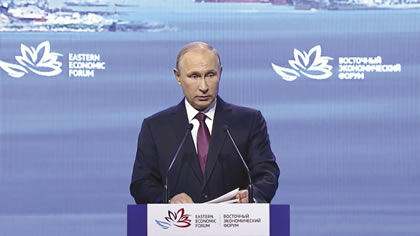
kremlin.ru
Vladimir Putin addressing the Eastern Economic Forum. |
Following Putin’s speech at the EEF, the North Korean delegate to the EEF, Minister of Foreign Economic Affairs Kim Yong Jae, said: “We are not opposed to trilateral cooperation, but this is not an appropriate situation for this to be implemented,” referring to the threats coming from the U.S.
As to the war danger, both Putin and Moon were totally clear. In an interview with TASS, Moon said, “Our stance is firm—there should be no more wars on the Korean Peninsula. Nobody but Korea is in the position to decide if there may be war on the Korean Peninsula again. We have no intention of toppling the North Korean regime or achieving unification by means of a takeover. We seek to resolve the North Korean nuclear problem and to guarantee security to the North Korean regime. We wish to build a system of lasting peace in the Korean Peninsula. Also, we wish to create an economic community in which the South and the North might prosper together. This would be useful for the development of Russia’s Far East, too.”
For his part, Putin, speaking in his press conference at the end of the BRICS Summit, said: “Everyone remembers well what happened to Iraq and Saddam Hussein. Hussein abandoned the production of weapons of mass destruction. Nonetheless, under the pretext of searching for these weapons, Saddam Hussein himself and his family were killed during the well-known military operation. Even children died back then. His grandson, I believe, was shot to death. The country was destroyed, and Saddam Hussein was hanged. Listen, everyone is aware of it and everyone remembers it. North Koreans are also aware of it and remember it. Do you think that following the adoption of some sanctions, North Korea will abandon its course on creating weapons of mass destruction? Russia condemns these exercises on the part of North Korea. We believe they are provocative in nature. However, we cannot forget about what I just said about Iraq, and what happened later in Libya. Certainly, the North Koreans will not forget it. Sanctions of any kind are useless and ineffective in this case. As I said to one of my colleagues yesterday, ‘they will eat grass, but they will not abandon this program unless they feel safe.’
“What can ensure security? The restoration of international law. We need to advance towards dialogue between all parties concerned. It is important for all participants in this process, including North Korea, not to have any thoughts about the threat of being destroyed; on the contrary, all sides to the conflict should cooperate. In this environment, in this situation, whipping up military hysteria is absolutely pointless; it is a dead end.”
|
kremlin.ru
President of the Republic of Korea Moon Jae-in (left) and Vladimir Putin making press statements following talks at the Eastern Economic Forum. |
Interestingly, in the EEF Plenary Session, Putin said that he saw willingness on the part of the Trump Administration to ease tensions with North Korea. “We can see the current Administration’s willingness to ease the situation,” he said.
It is of note that the U.S. was represented at the EEF by 400 participants, including executives of ExxonMobil, IBM, and Abbott Laboratories. It should be obvious to American business interests that it is insane for the U.S. to be largely boycotting the biggest economic development process in history, on a global scale, because of the Obama Administration’s demonization of Russia and his military and economic encirclement of China, through the Pivot to Asia and the Trans-Pacific Partnership (TPP).
Trump has pulled out of the TPP, and has made it clear that America’s interests are best served by cooperation with Russia and China. A total of 217 agreements worth nearly $44 billion were signed at the EEF, according to the Russian presidential envoy to the Far East Federal District, Yury Trutnev. Unfortunately, none were with American firms.
Asia Moves Ahead
Other Great Projects are getting underway in Asia. On Monday, September 11, a major conference is being held in Bangkok on the building of the Kra Canal (now called the Thai Canal), involving several of the people who participated in a Kra Canal conference held in Bangkok in 1984, where Lyndon LaRouche was a keynote speaker along with leading political and scientific figures from Thailand, Japan, and across Asia. The project was delayed by a combination of political crises and the so-called Asian Financial Crisis of 1998. It has now gained new impetus from the Belt and Road Initiative, as it would be a key hub for the 21st Century Maritime Silk Road.


